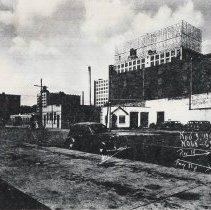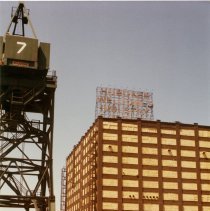For some Hoboken residents, the Hudson Tea building is nothing more than a luxury apartment building with stunning views and luxury amenities, but little do many know that there’s actually a very interesting + unique history to the building. For today’s Hoboken TBT, we are going back in time to 1913 to visit the original Lipton Tea Warehouse on the waterfront of Hoboken. Keep reading to learn all about the former Lipton Tea Warehouse in Hoboken, now the Hudson Tea buildings at 1500 Washington.

(Photo credit: Hoboken Historical Museum)
The Old Waterfront
The Hoboken waterfront once looked much different than the waterfront we know today, populated with luxury apartment buildings and beautiful parks. In the early 1900s, the waterfront was dotted with ports and docks for shipping vessels from all over the world. One prolific company that made their home in Hoboken was Lipton Tea.
About Lipton Tea
The Lipton Tea Company was started by Sir Thomas Lipton, who originally owned grocery stores in the United Kingdom. Finding the quality of the teas for sale lacking, Sir Lipton purchased tea fields in Sri Lanka to make his own tea for sale in his shops. Starting with one store in Glasgow, Sir Lipton’s empire eventually grew to over 200 stores across the UK by 1900. However, Thomas’s ambition soon grew beyond what he had accomplished in Europe, and he was ready to expand his reach across the ocean — he just had to find the right place. Hoboken offered good port access, room for growth, and easy access to New York City (exactly what Sir Lipton was looking for), and so he built his manufacturing plant on the shores of the Hudson River.
See More: Then and Now: Hoboken’s History Through Postcards
Lipton Tea in Hoboken

(Photo credit: Hoboken Historical Museum)
Starting with the establishment of the packaging company and manufacturing center in Hoboken, Sir Lipton began looking for ways to make packaging and shipping less expensive. The Hoboken hub made it easy for shipments to come in from Sir Lipton’s Sri Lankan tea plantation, to then be distributed across the U.S. The opening of the Hoboken manufacturing plant came at the same time as Maxwell Coffee, Bethlehem Steel, and Hostess, bringing strong unions and a booming industry to the Mile Square.
Unfortunately, with the rise of innovation came troubled times for the docks in Hoboken. With the development of the Interstate Highway System and the increase in containerization (using shipping containers which can easily be transferred from ship to train, making transporting goods much more seamless and standardized), the docks became less necessary. When the Lipton Plant closed in Hoboken in 1963, it moved to nearby Englewood Cliffs and the Tea Building spot was ripe for a new purpose.
The Building Today
In the late 1990s, the property was converted into rental apartments and renamed the Hudson Tea Building. The rentals lasted for a few years before the building was purchased by the Toll Brothers, who converted the rental apartments into condominiums.
Read More: Hoboken #TBT: The Houses of Hudson Street
Famous residents of the Hudson Tea buildings have included Eli Manning, who lived in the building from 2008 until 2018, and former New Jersey Governor Jon Corzine.
Have some Hudson history to share? Email us photos or your story to hello@hobokengirl.com.










